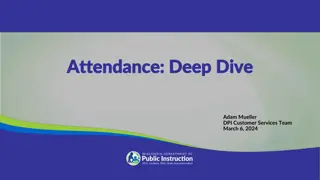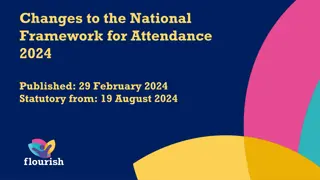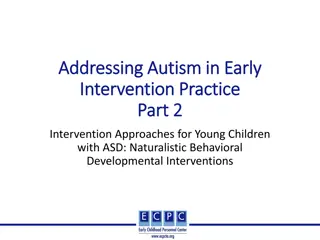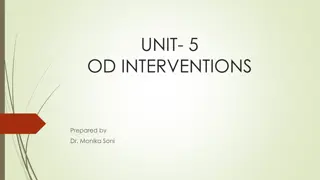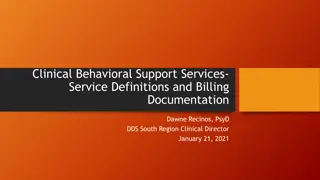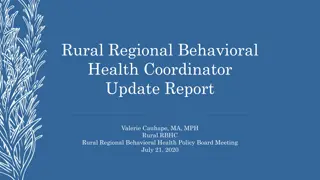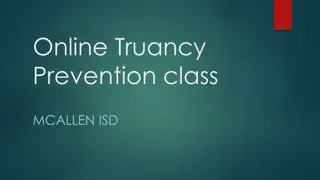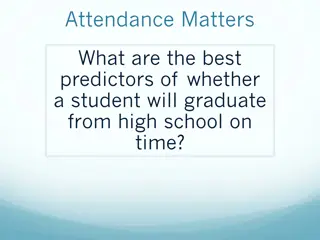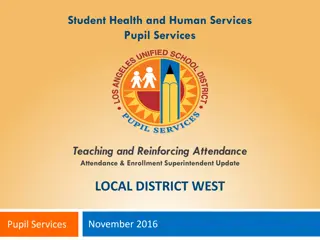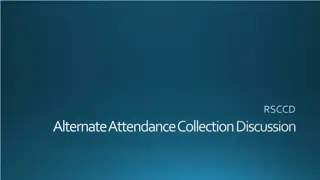Enhancing Student Attendance Through Behavioral Science Interventions
Explore EveryDay Labs' program for addressing chronic absence through innovative interventions like nudges, family communication, and truancy support. Learn how behavioral science concepts are leveraged to promote healthy behaviors and improve student attendance. The program includes targeted mail and text nudges, family support teams, and professional learning sessions to drive engagement and academic progress.
Download Presentation

Please find below an Image/Link to download the presentation.
The content on the website is provided AS IS for your information and personal use only. It may not be sold, licensed, or shared on other websites without obtaining consent from the author. Download presentation by click this link. If you encounter any issues during the download, it is possible that the publisher has removed the file from their server.
E N D
Presentation Transcript
EveryDay Labs Orientation & Dashboard Support January 23, 2024
Agenda 1. EveryDay Labs Background 2. Program Overview - What to Expect 3. Review Self Assessment & Action Planning 4. Break 5. EveryDay Pro - Attendance Dashboard Intro 6. Creating High Quality Intervention Groups
EveryDay Labs Background
EveryDay Labs: Behavioral science is at our core Family Communication Attendance
Program Overview - Collaborating with You Our Intervention Our intervention is part of your systemic approach to attendance and compliments your work
2023-2024 Program Chronic Absence Communications: Mail and Text Nudge Intervention 4-5 rounds of letters to families of students with 5-95% absenteeism sent every 6-8 weeks Biweekly attendance texts sent to families of students with 5-95% absenteeism Family Support Team and 2-way Family Support Bot Truancy Intervention Weekly truancy notices sent to qualifying families Student must be selected (opted in) by district staff by Friday to receive the following week EveryDay Pro and EveryDay Learning Attendance analytics, case management tools, and intervention tracking and coordination 4 professional learning sessions
What Are Nudges? A nudge is a nonpunitive way to promote a healthy behavior Concept from behavioral science leveraged across industries
Standard Mail Nudge Mail Nudge Misconception #1: Families underestimate their students total absences by 50% Our attendance Nudges address the three critical parent misconceptions about attendance. Misconception #2: Families underestimate the link between attendance and academic progress. Designed for all families and guardians: - 5th grade reading level - English & Spanish - Simple graph Nudges include both excused and unexcused absences because all absences result in loss of instructional time. Misconception #3: Families believe that their students attendance is average or better than average.
Mail nudges sent to families 6x annually Mail Nudge Designed for accessibility, written at 5th grade reading level Multi-lingual Address common misconceptions about attendance Approach parents as partners, rather than using punitive or legal language Employ the science of behavior change Provide resources to families Over 50% families report keeping nudges in their home
Text Nudge TPSS Note: families will first receive an intro/opt out text Hi from TPSS Attendance Updates! Casey has missed 7 days this school year. We can help with attendance, wellness, and more. and more - just text the word SUPPORT Welcome to TPSS Attendance Updates! We may send you occasional updates about your student's progress. Msg&data rates may apply. Text STOP to stop. Text nudges are sent bi-weekly, providing access to 24/7 support bot and phone-based family support team Support How can we help? You can text: ATTENDANCE SCHOOL for school resources (student meals, school buses, etc) MORE for community resources (groceries, housing, etc) OTHER for anything else Intro/Opt Out
Family Support Team Families receiving mail or text nudges will see a phone number they can call for questions. They will be in touch with our multilingual Family Support Team, who can direct them to resources. Common Household Questions Household Testimonials Academic calendar dates (e.g., breaks) Details around absences District resource requests (e.g., food, internet connectivity) In-person v. remote learning School contact information Thank you for listening to me and for being so kind. You have no idea how much help this has been for me." "Because of our situation, it helps to have extra tools out there. Thank you so much for doing this"
What can you expect? We want (and expect) you to hear from families. The goal is to connect families back to your school sites, so that families can access what they need and build relationships with you. Share FAQ doc with front office staff and let them know they might have more families calling in about the letters - Remind staff of ways your district can support families in overcoming barriers to attendance -
A Systemic Approach
Supports for Students Social Emotional Supports Community Resources Accelerated Learning On Time Graduation Teacher Effectiveness HealthCare Solutions Safe Environments ATTENDANCE
Three Attendance Metrics 1. Average Daily Attendance 2. Truancy 3. Chronic Absenteeism
Average Daily Attendance (ADA): Tracking ADA allows you to monitor overall health of school/district attendance set school-wide goals reward staff/students for improvement
Chronic Absence Truancy Counts all absences: excused, unexcused, & suspensions Emphasizes academic impact of missed days Uses community-based, positive strategies Counts only unexcused absences Emphasizes compliance Relies on legal & administrative solutions Chronic Absenteeism = Missing 10% of Enrolled Days
In Elementary School: Weaker development of social skills Less likely to read well by 3rdgrade More likely to be retained Academic Consequences of Chronic Absenteeism In Middle School Lower grades and test scores A warning sign that students will eventually drop out In High School Lower grades and test scores Lower graduation rates Lower rates of college enrollment & completion
The Impact on Student & School Success Attendance Band Avg. Percentile Reading Avg. Percentile Math 95%+ (N=16,273) 50.3 44.2 90-94.9% (N=2,530) 38.8 32.0 85-89.9% (N=966) 36.0 30.3 80-84.9% (N=486) 33.0 29.7 <80% (N=580) 31.1 24.9 2021 data from a large urban district & current partner
The Impact on Student & School Success Attendance Band Avg. Percentile Reading Avg. Percentile Math 95%+ (N=16,273) 50.3 44.2 90-94.9% (N=2,530) 38.8 32.0 85-89.9% (N=966) 36.0 30.3 80-84.9% (N=486) 33.0 29.7 <80% (N=580) 31.1 24.9 2021 data from a large urban district & current partner
System of Support District and School Wide Prevention & Attendance Promotion Small Group Interventions Individual Supports
Reflect: Which part of the systemic approach is widely understood at your school/district? Which part is less understood?
Effective Attendance Teams
Attendance Team Focus & Responsibilities: Meet Regularly Analyze data & share data across school sites and with families Plan schoolwide approaches Create a Tiered System of Support Support classrooms and gather necessary materials Provide ongoing communication on attendance data & team/school efforts with staff, students & families
Attendance Team Members Team should include members from across the school staff: 1. At least one administrator 2. At least one interventionist (counselor, social worker, etc.) 3. Several teachers (general and special education) 4. School resource officer or campus security 5. Attendance clerk 6. One student representative (include for parts of meeting) 7. One parent representative (include for parts of meeting)
Two Types of Team Meetings Quarterly Step Back Meetings - Analyze long-term data - Reflect on system of interventions at each tier - Create long term goals Bi-Weekly Meetings - Analyze data - Plan interventions - Track interventions Example: Look at recent data for a group of students with 10-15% absence rate to determine if group intervention is effective. Example: Look at daily attendance rates from last year to determine when to launch an attendance campaign around holidays.
Bi-Weekly Data Metrics to Track - ADA & chronic absenteeism rates by grade and/or teacher - Student lists in the following tiers: - At Risk students: 5-9% absenteeism - Moderate Chronic students: 10-19% absenteeism - Severe/Extreme Chronic students: >20% absenteeism - Individual student Data
Metrics to Analyze at Quarterly Meetings Attendance rate by subgroups/Cohorts Race/Ethnicity; Gender; FRPL Status; ELL status; Grade Level Daily attendance rate for whole school Scores on Attendance Self-Assessment
Analyze the Rubric Find the Attendance Team Section What is one area that your school teams is excelling in? Which area could your school teams use more support in?
Action Planning Take a minute to review the action planning doc after analyzing the rubric. Complete the first two sections.
Lets get organized Login to the platform and choose a school to study for the day https://pro.everydaylabs.com To log-in: To log in for the first time, you will need to click on forgot password to create a new password. Your username is your email address Reach out if you have any questions or need help!
EveryDay Pro - Attendance Dashboard Demo
Dashboard Highlights Quick Snapshot: School/District Overview Useful for Attendance Team Metrics Student Cohort Grade Level, Race, Ethnicity, Special Ed, Homeless Metrics Attendance Calendar Seeing Attendance Rates Day by Day + Patterns/Trends Student List + Student Profile Individual Student Lists + Daily Attendance Patterns Intervention Groups Create intervention groups & monitor effectiveness
Quick Tour Side Bar Resource Center Magnifying Glass Data Updated when Multi-Year view Download Button Information Button Chat Feature
Attendance Dashboard Purpose: Find key metrics for individual schools: 1. Attendance Rates (monthly & Year-To-Date) 1. Chronic Absenteeism Rates (monthly & Year-To-Date) 1. Absence Rates by Tier (% & # of students)
Attendance Dashboard Guiding Questions 1. How have chronic absenteeism rates changed over time? 2. How has attendance changed over time? 3. What are our YTD metrics for chronic absenteeism and attendance? 4. Which months have our rates been highest? Lowest? 5. What percentage of students are in Tier II? 6. How many students are chronically absent right now?
Attendance Calendar Purpose: track daily attendance rates for the district & school and locate patterns/trends + dip days (days where school attendance is significantly lower) Are there days of the week where there is a pattern of lower attendance? Are there significant dip days? How can I use this information to inform my calendar next year? How can I counteract these dip days?
Student Cohorts Purpose: slice data by student groups in order to see if there are patterns or trends. grade level FRPL (free/reduced lunch) Race Ethnicity Gender Homeless status
Student Cohorts Which grade levels have higher attendance rates? Lower? How does the attendance rate for students of one ethnicity compare to another?
Student Dashboard Purpose: Identify student lists within absence tiers & analyze individual student data for patterns & trends. Who is missing between 10-19% of school? Who is at risk for becoming chronically absent? Who is already severely absent? Are students exhibiting the following patterns? - Vacation Extending - Day of the Week Missers - Single v. Multi-Day Missers
Scavenger Hunt - 8-10 minutes Locate the following data metrics for your school: Year-To-Date Chronic Absenteeism rate in August: Monthly Chronic absenteeism rate in September: % of students missing between 10-19%: # of students missing between 4-9%: Year-To-Date Attendance Rate for one specific grade level at your school
Utilizing EveryDay Pro to Create High Quality Intervention Groups
Our Goal We hope that after today you will walking away knowing how to: Tie interventions to barriers students are experiencing Ground tiered interventions in real data Utilize the resource center to improve and enhance tiered interventions Create 3 intervention groups
Tiered Data and Interventions
Treating Chronic Absenteeism It s Chronic - Must be treated in regular intervals - One intervention may not result in long-term change - Plan for regular non-punitive interventions for families/students Barriers to Attendance - Chronically absent students and/or their families experience an average of 9 barriers to attendance Interventions should be: Non- Punitive Positive Solution Based
System of Support Analyze Data Look for patterns & trends in the data Use barrier assessments to better understand challenges students are facing Recommend group and/or individual interventions for students Monitor with frequency
Common Causes of Absenteeism 1. Physical barriers to attendance 2. Lack of value placed on school 3. Lack of understanding about the importance of attendance 4. Escape or avoidance 5. Desire to obtain or access something outside of school










